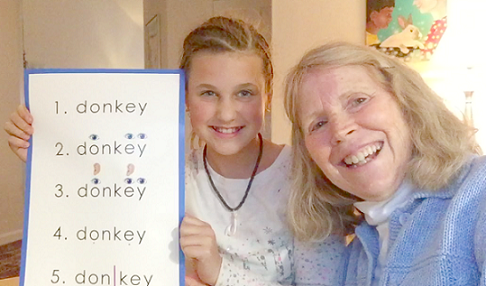Pre-schoolers Blossoming with Silent Elephant “e”!
At the very end of June 2020, I had the pleasure to begin tutoring a four-year-old pre-Kindergartener with Phonetic Reading with Silent Elephant “e”.
This bubbly, spunky, sweet little girl had hardly had the opportunity to attend pre-school before COVID.
“Chloe” loved being read to but at that time wasn’t at all interested in learning to read herself. Chloe’s parents definitely wanted her to learn to read and were concerned about what her soon to be on-line Kindergarten experience would be like. She didn’t have any discernable learning differences; she was a happy bouncy 4-year-old.
Since Chloe was only 4 years old, I began our Zoom sessions tutoring her for only about 20 minutes a day 5 days per week using Silent Elephant “e”’s caterpillar and train games.
Young children, really ALL children, need to have FUN while learning, so I kept every lesson upbeat and positive with lots of smiles, giggles, and encouragement. I never rushed Chloe through a lesson; we progressed at her pace. We only moved to the next phonemic awareness lesson when I knew she had mastered the lesson we were working on.
As we progressed, she became more and more interested in what she was learning and began to work diligently to learn phonemic awareness.
The phonemic awareness portion of Chloe’s lesson only lasted about 9 to 10 minutes, then she and I would sing our hearts out as we sang our special version of “Old McDonald” at the top of our lungs to learn the short vowel sounds. (See my blog post https://www.silentelephante.com/blog/category/Vowels at www.silentelephant.com to learn my adapted version of “Old McDonald and how to use it.)
After enthusiastically singing, if Chloe wanted to learn one new reading word, both of us would write the word using specific colors on 4” x 6” note cards. Because she was only 4 years old, I didn’t push her, we spent time forming the letters and remembering the sounds as we created her new word. For this part of Silent Elephant “e” I use the Fry Sight Word List of 700 words. (Learn in detail how I teach sight words at https://www.silentelephante.com/blog/2021/2/15/how-do-you-teach-sight-words-36Xh1. This sight word blog post explains why some sight words are really phonetic, https://www.silentelephante.com/blog/2021/2/15/ts-truesome-sight-words-are-really-phonetic-heres-why)
Whenever Chloe was still eager to learn, we delved into the phonics part of her lesson. We used Silent Elephant “e”, Part 3. Using Silent Elephant “e”’s excellent, extremely well organized “cookbook” directions, I made sure that Chloe knew letter sounds and letter names; the difference between sight words and phonetic words; how to read simple short vowel VC and CVC words; and how to read, write, spell, and comprehend sentences. At the end of Part 3, Chloe learned about root words and the suffix -s.
In September of 2020, Chloe was ready for 30 minutes a day. She was excited to learn—truly bouncing in her chair! The more she learned, the more eager she was to learn!
By January 8th of 2021, she had mastered the entire Part I, Phonemic Awareness section of Silent Elephant “e” with 100% accuracy on both assessments!
At the beginning of February 2021, she was reading, writing, and spelling at a second semester 1st grade reading level (one full year above her expected reading level)! She read smoothly using beautiful expression and comprehended everything she read!
At the completion of her Kindergarten year in June of 2021, Chloe was reading, writing, and spelling at a 4th grade reading level with excellent word recognition and comprehension! She loved reading.
Presently (November of 2021), Chloe continues to tutor with me only twice a week for 45-minute sessions. She is now at a 5th grade reading level in first grade! She is in Part 7 of Silent Elephant “e”! Her parents want her to continue with me because she is having so much fun and learning so quickly.
I’m so happy to share this success story with you! I’m so proud of Chloe! It has been so fun to watch how a young learner without any learning differences speeds through the lessons with confidence, eagerness and joy.
Teaching children beginning in preschool with Phonetic Reading with Silent Elephant “e”, provides them with the best learning tools in lessons that are FUN—using their whole body to learn!
Recently I began tutoring two three-year-olds in phonemic awareness! We are having a great time playing the caterpillar and train games with no real expectations! It’s such a pleasure for me to watch these two young minds at work as they eagerly understand how our language works. They are a joy.
Just imagine where they’ll be a year from now!
Contact us with questions at:
LInda Katherine Smith-Jones Nina Henson
Keep a song in your heart!


































